ITC508 - Collin's ATM System: Developing UML Diagrams for ATM Design
VerifiedAdded on 2023/06/12
|8
|1318
|294
Case Study
AI Summary
This case study provides a detailed analysis of Collin's ATM system, focusing on the design and implementation using UML diagrams. The system includes components such as a card reader, keypad, display, cash dispenser, and printer. The key requirements covered are customer service, card recognition, PIN verification, account selection, and transaction processing. The solution includes a sequence diagram illustrating the interaction between users, the ATM interface, the ATM core processor, the consortium, and the bank. The sequence diagram outlines the steps involved in a typical ATM transaction, from card insertion to cash dispensing. Additionally, a class diagram is presented, showcasing the relationships between different classes within the system. The case study also addresses transaction options such as withdrawals, deposits, balance inquiries, and money transfers. The ATM system is designed to generate reports on a daily, weekly, monthly, and yearly basis to track cash flow. Desklib offers this and many other solved assignments to aid students in their studies.
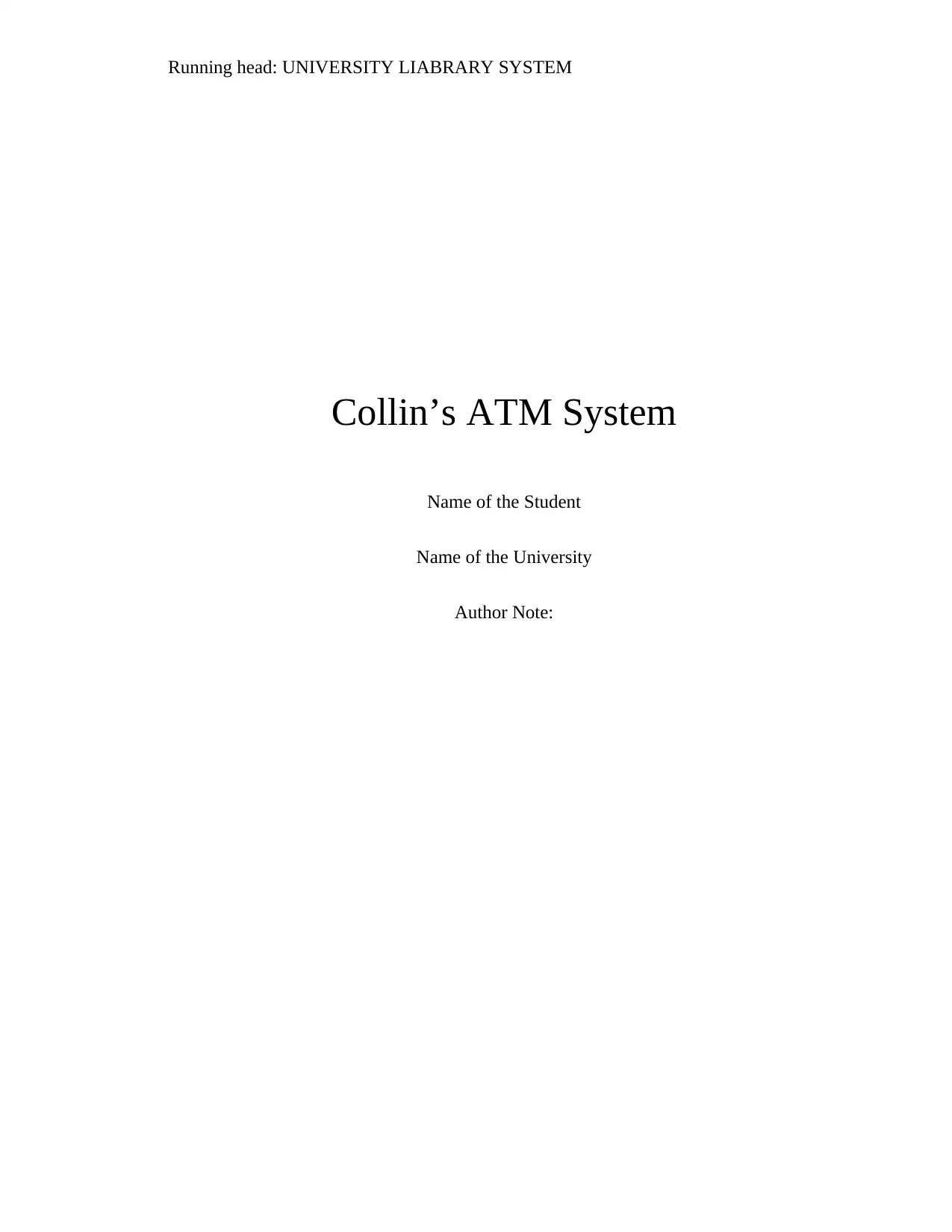
Running head: UNIVERSITY LIABRARY SYSTEM
Collin’s ATM System
Name of the Student
Name of the University
Author Note:
Collin’s ATM System
Name of the Student
Name of the University
Author Note:
Paraphrase This Document
Need a fresh take? Get an instant paraphrase of this document with our AI Paraphraser
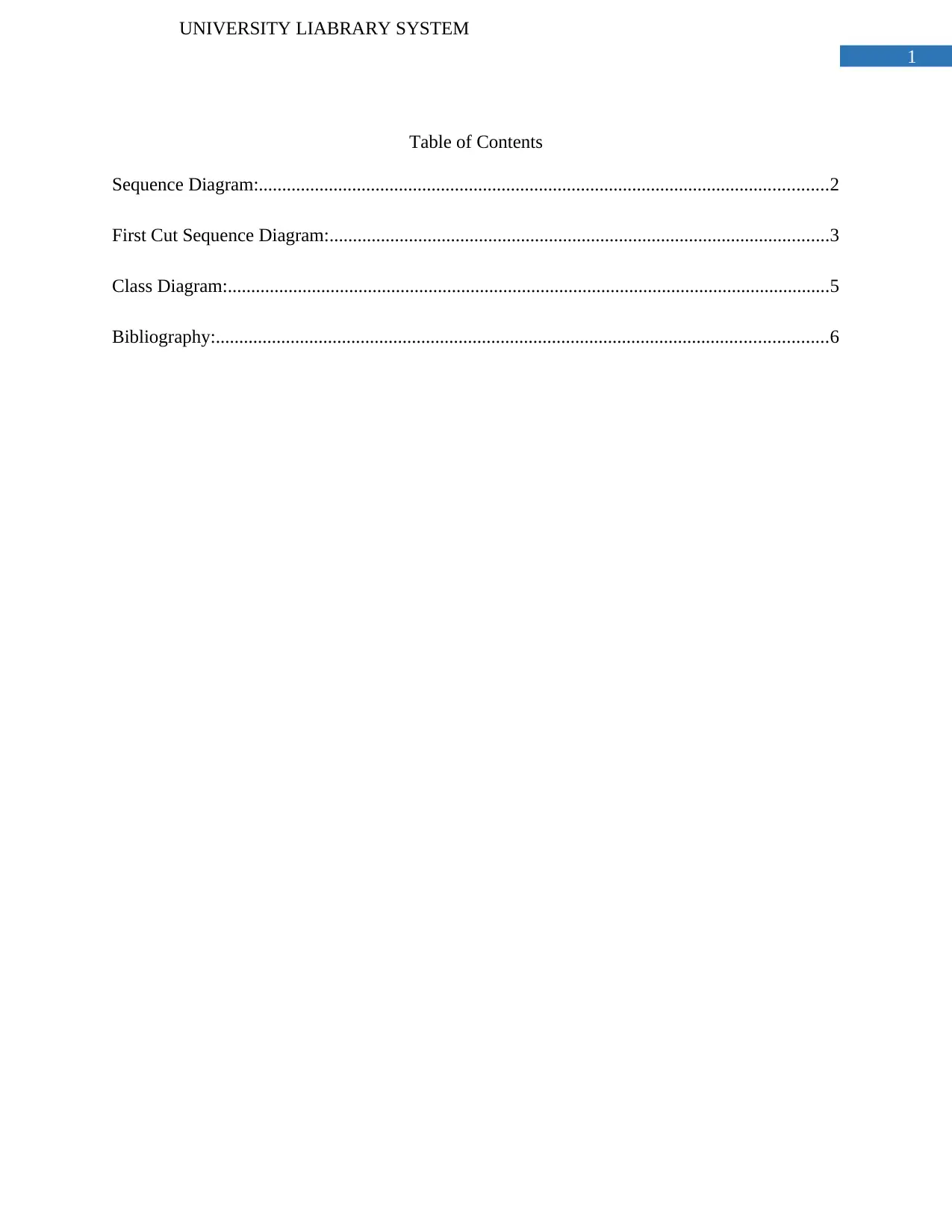
1
UNIVERSITY LIABRARY SYSTEM
Table of Contents
Sequence Diagram:..........................................................................................................................2
First Cut Sequence Diagram:...........................................................................................................3
Class Diagram:.................................................................................................................................5
Bibliography:...................................................................................................................................6
UNIVERSITY LIABRARY SYSTEM
Table of Contents
Sequence Diagram:..........................................................................................................................2
First Cut Sequence Diagram:...........................................................................................................3
Class Diagram:.................................................................................................................................5
Bibliography:...................................................................................................................................6
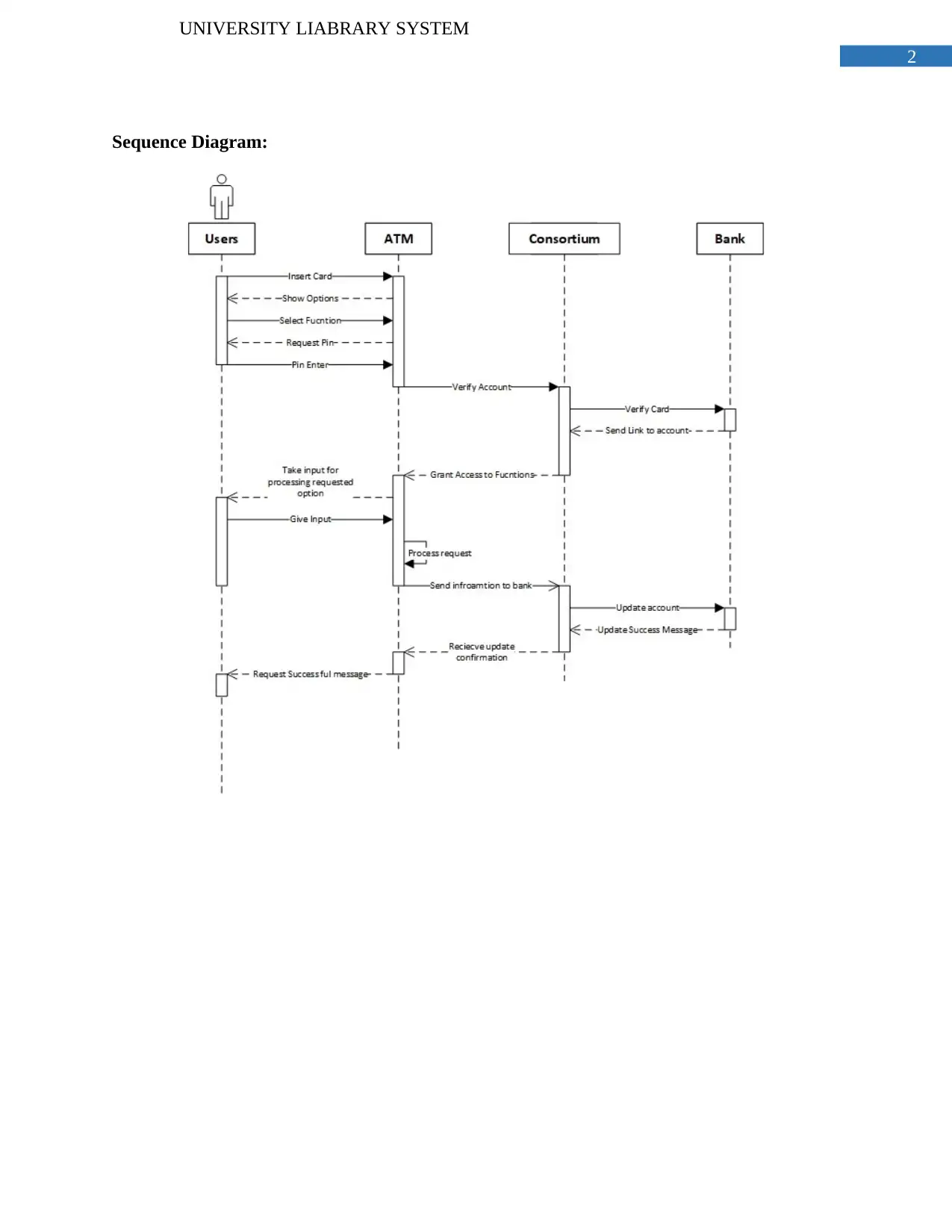
2
UNIVERSITY LIABRARY SYSTEM
Sequence Diagram:
UNIVERSITY LIABRARY SYSTEM
Sequence Diagram:
⊘ This is a preview!⊘
Do you want full access?
Subscribe today to unlock all pages.

Trusted by 1+ million students worldwide
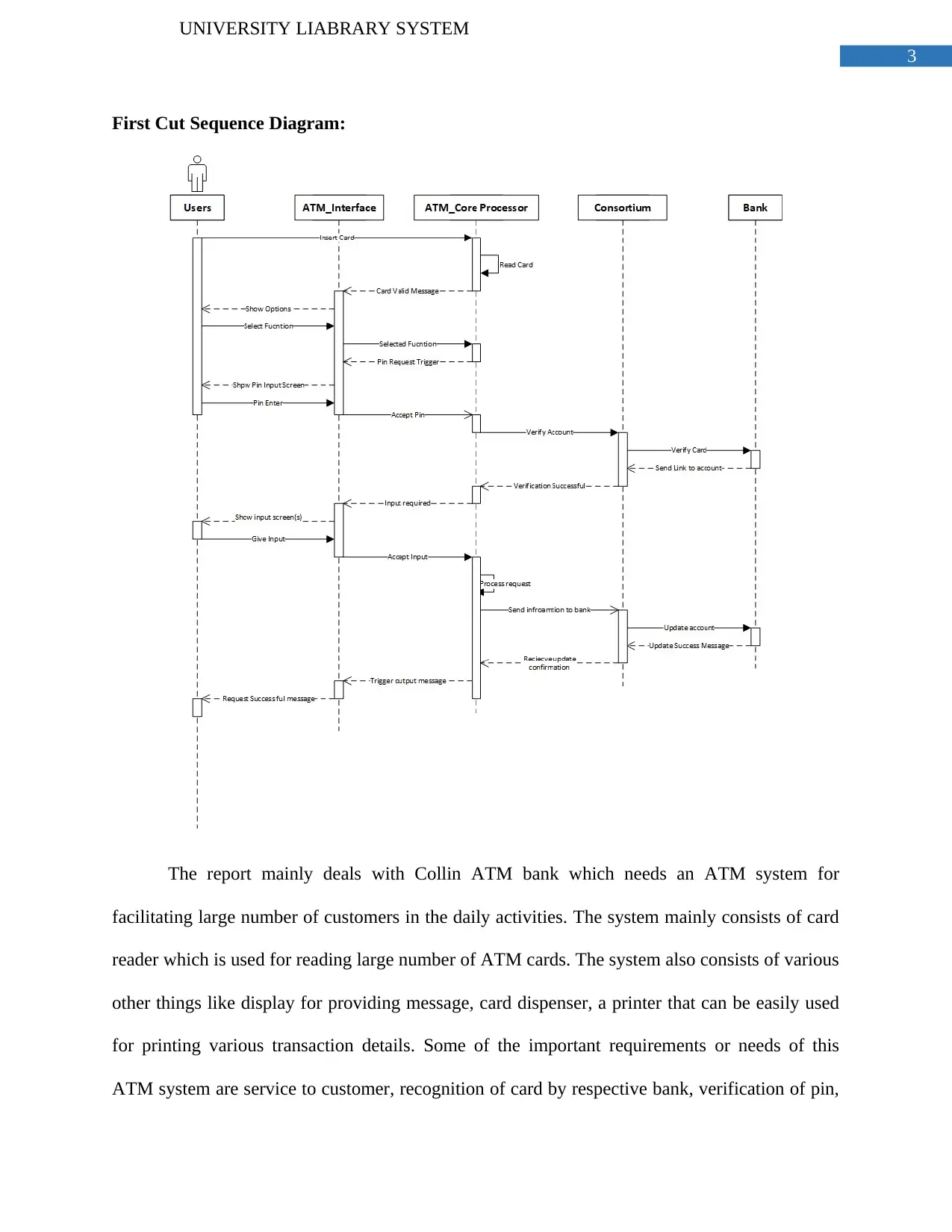
3
UNIVERSITY LIABRARY SYSTEM
First Cut Sequence Diagram:
The report mainly deals with Collin ATM bank which needs an ATM system for
facilitating large number of customers in the daily activities. The system mainly consists of card
reader which is used for reading large number of ATM cards. The system also consists of various
other things like display for providing message, card dispenser, a printer that can be easily used
for printing various transaction details. Some of the important requirements or needs of this
ATM system are service to customer, recognition of card by respective bank, verification of pin,
UNIVERSITY LIABRARY SYSTEM
First Cut Sequence Diagram:
The report mainly deals with Collin ATM bank which needs an ATM system for
facilitating large number of customers in the daily activities. The system mainly consists of card
reader which is used for reading large number of ATM cards. The system also consists of various
other things like display for providing message, card dispenser, a printer that can be easily used
for printing various transaction details. Some of the important requirements or needs of this
ATM system are service to customer, recognition of card by respective bank, verification of pin,
Paraphrase This Document
Need a fresh take? Get an instant paraphrase of this document with our AI Paraphraser
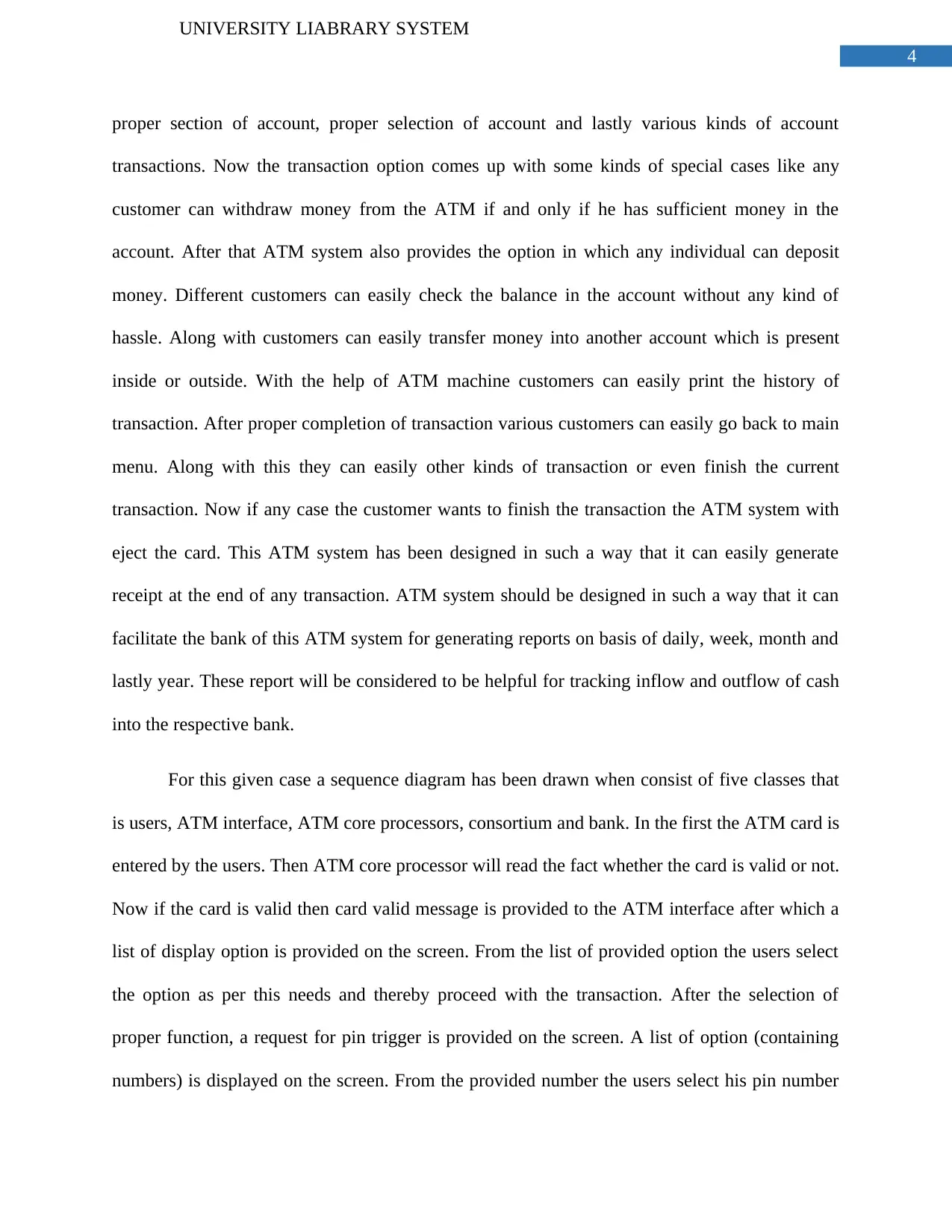
4
UNIVERSITY LIABRARY SYSTEM
proper section of account, proper selection of account and lastly various kinds of account
transactions. Now the transaction option comes up with some kinds of special cases like any
customer can withdraw money from the ATM if and only if he has sufficient money in the
account. After that ATM system also provides the option in which any individual can deposit
money. Different customers can easily check the balance in the account without any kind of
hassle. Along with customers can easily transfer money into another account which is present
inside or outside. With the help of ATM machine customers can easily print the history of
transaction. After proper completion of transaction various customers can easily go back to main
menu. Along with this they can easily other kinds of transaction or even finish the current
transaction. Now if any case the customer wants to finish the transaction the ATM system with
eject the card. This ATM system has been designed in such a way that it can easily generate
receipt at the end of any transaction. ATM system should be designed in such a way that it can
facilitate the bank of this ATM system for generating reports on basis of daily, week, month and
lastly year. These report will be considered to be helpful for tracking inflow and outflow of cash
into the respective bank.
For this given case a sequence diagram has been drawn when consist of five classes that
is users, ATM interface, ATM core processors, consortium and bank. In the first the ATM card is
entered by the users. Then ATM core processor will read the fact whether the card is valid or not.
Now if the card is valid then card valid message is provided to the ATM interface after which a
list of display option is provided on the screen. From the list of provided option the users select
the option as per this needs and thereby proceed with the transaction. After the selection of
proper function, a request for pin trigger is provided on the screen. A list of option (containing
numbers) is displayed on the screen. From the provided number the users select his pin number
UNIVERSITY LIABRARY SYSTEM
proper section of account, proper selection of account and lastly various kinds of account
transactions. Now the transaction option comes up with some kinds of special cases like any
customer can withdraw money from the ATM if and only if he has sufficient money in the
account. After that ATM system also provides the option in which any individual can deposit
money. Different customers can easily check the balance in the account without any kind of
hassle. Along with customers can easily transfer money into another account which is present
inside or outside. With the help of ATM machine customers can easily print the history of
transaction. After proper completion of transaction various customers can easily go back to main
menu. Along with this they can easily other kinds of transaction or even finish the current
transaction. Now if any case the customer wants to finish the transaction the ATM system with
eject the card. This ATM system has been designed in such a way that it can easily generate
receipt at the end of any transaction. ATM system should be designed in such a way that it can
facilitate the bank of this ATM system for generating reports on basis of daily, week, month and
lastly year. These report will be considered to be helpful for tracking inflow and outflow of cash
into the respective bank.
For this given case a sequence diagram has been drawn when consist of five classes that
is users, ATM interface, ATM core processors, consortium and bank. In the first the ATM card is
entered by the users. Then ATM core processor will read the fact whether the card is valid or not.
Now if the card is valid then card valid message is provided to the ATM interface after which a
list of display option is provided on the screen. From the list of provided option the users select
the option as per this needs and thereby proceed with the transaction. After the selection of
proper function, a request for pin trigger is provided on the screen. A list of option (containing
numbers) is displayed on the screen. From the provided number the users select his pin number
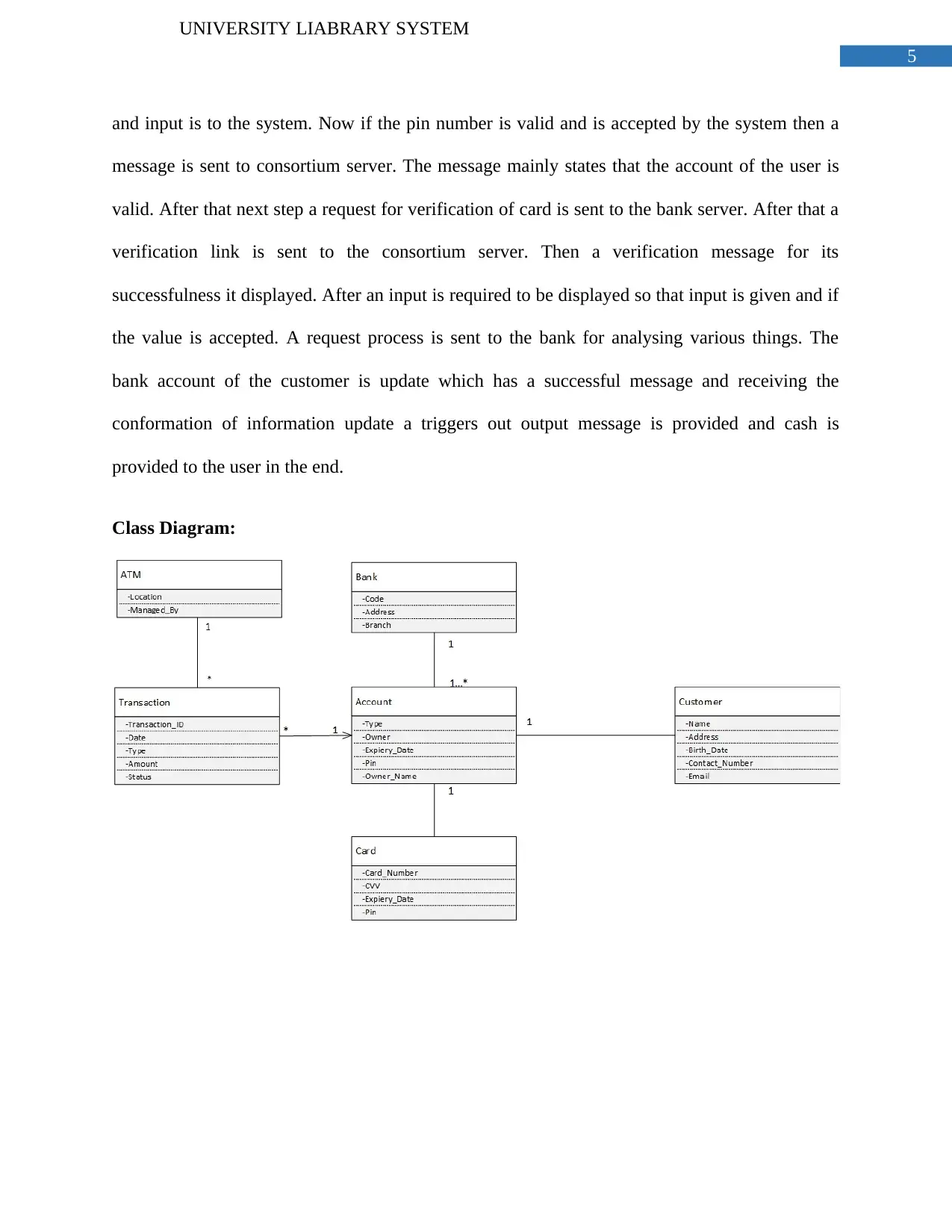
5
UNIVERSITY LIABRARY SYSTEM
and input is to the system. Now if the pin number is valid and is accepted by the system then a
message is sent to consortium server. The message mainly states that the account of the user is
valid. After that next step a request for verification of card is sent to the bank server. After that a
verification link is sent to the consortium server. Then a verification message for its
successfulness it displayed. After an input is required to be displayed so that input is given and if
the value is accepted. A request process is sent to the bank for analysing various things. The
bank account of the customer is update which has a successful message and receiving the
conformation of information update a triggers out output message is provided and cash is
provided to the user in the end.
Class Diagram:
UNIVERSITY LIABRARY SYSTEM
and input is to the system. Now if the pin number is valid and is accepted by the system then a
message is sent to consortium server. The message mainly states that the account of the user is
valid. After that next step a request for verification of card is sent to the bank server. After that a
verification link is sent to the consortium server. Then a verification message for its
successfulness it displayed. After an input is required to be displayed so that input is given and if
the value is accepted. A request process is sent to the bank for analysing various things. The
bank account of the customer is update which has a successful message and receiving the
conformation of information update a triggers out output message is provided and cash is
provided to the user in the end.
Class Diagram:
⊘ This is a preview!⊘
Do you want full access?
Subscribe today to unlock all pages.

Trusted by 1+ million students worldwide
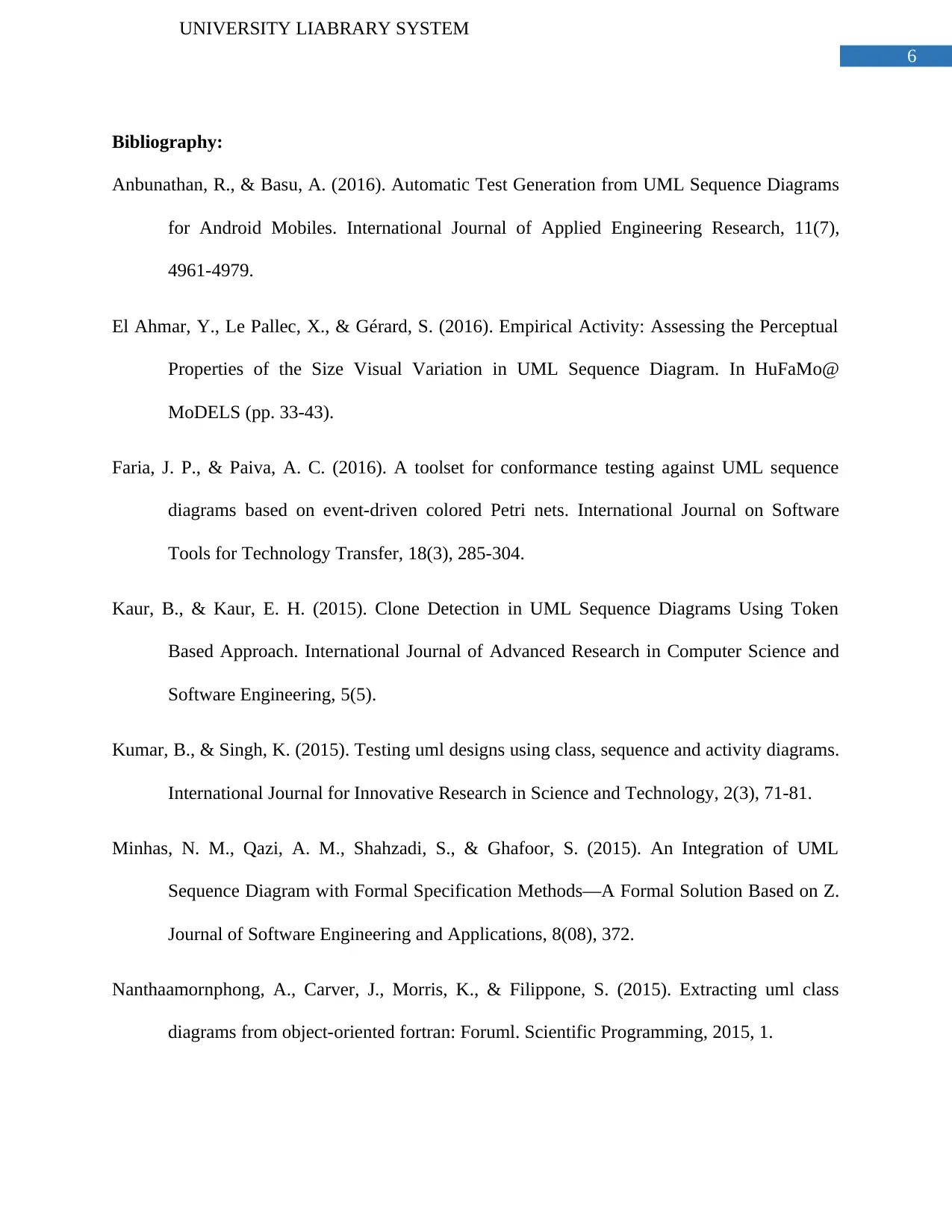
6
UNIVERSITY LIABRARY SYSTEM
Bibliography:
Anbunathan, R., & Basu, A. (2016). Automatic Test Generation from UML Sequence Diagrams
for Android Mobiles. International Journal of Applied Engineering Research, 11(7),
4961-4979.
El Ahmar, Y., Le Pallec, X., & Gérard, S. (2016). Empirical Activity: Assessing the Perceptual
Properties of the Size Visual Variation in UML Sequence Diagram. In HuFaMo@
MoDELS (pp. 33-43).
Faria, J. P., & Paiva, A. C. (2016). A toolset for conformance testing against UML sequence
diagrams based on event-driven colored Petri nets. International Journal on Software
Tools for Technology Transfer, 18(3), 285-304.
Kaur, B., & Kaur, E. H. (2015). Clone Detection in UML Sequence Diagrams Using Token
Based Approach. International Journal of Advanced Research in Computer Science and
Software Engineering, 5(5).
Kumar, B., & Singh, K. (2015). Testing uml designs using class, sequence and activity diagrams.
International Journal for Innovative Research in Science and Technology, 2(3), 71-81.
Minhas, N. M., Qazi, A. M., Shahzadi, S., & Ghafoor, S. (2015). An Integration of UML
Sequence Diagram with Formal Specification Methods—A Formal Solution Based on Z.
Journal of Software Engineering and Applications, 8(08), 372.
Nanthaamornphong, A., Carver, J., Morris, K., & Filippone, S. (2015). Extracting uml class
diagrams from object-oriented fortran: Foruml. Scientific Programming, 2015, 1.
UNIVERSITY LIABRARY SYSTEM
Bibliography:
Anbunathan, R., & Basu, A. (2016). Automatic Test Generation from UML Sequence Diagrams
for Android Mobiles. International Journal of Applied Engineering Research, 11(7),
4961-4979.
El Ahmar, Y., Le Pallec, X., & Gérard, S. (2016). Empirical Activity: Assessing the Perceptual
Properties of the Size Visual Variation in UML Sequence Diagram. In HuFaMo@
MoDELS (pp. 33-43).
Faria, J. P., & Paiva, A. C. (2016). A toolset for conformance testing against UML sequence
diagrams based on event-driven colored Petri nets. International Journal on Software
Tools for Technology Transfer, 18(3), 285-304.
Kaur, B., & Kaur, E. H. (2015). Clone Detection in UML Sequence Diagrams Using Token
Based Approach. International Journal of Advanced Research in Computer Science and
Software Engineering, 5(5).
Kumar, B., & Singh, K. (2015). Testing uml designs using class, sequence and activity diagrams.
International Journal for Innovative Research in Science and Technology, 2(3), 71-81.
Minhas, N. M., Qazi, A. M., Shahzadi, S., & Ghafoor, S. (2015). An Integration of UML
Sequence Diagram with Formal Specification Methods—A Formal Solution Based on Z.
Journal of Software Engineering and Applications, 8(08), 372.
Nanthaamornphong, A., Carver, J., Morris, K., & Filippone, S. (2015). Extracting uml class
diagrams from object-oriented fortran: Foruml. Scientific Programming, 2015, 1.
Paraphrase This Document
Need a fresh take? Get an instant paraphrase of this document with our AI Paraphraser
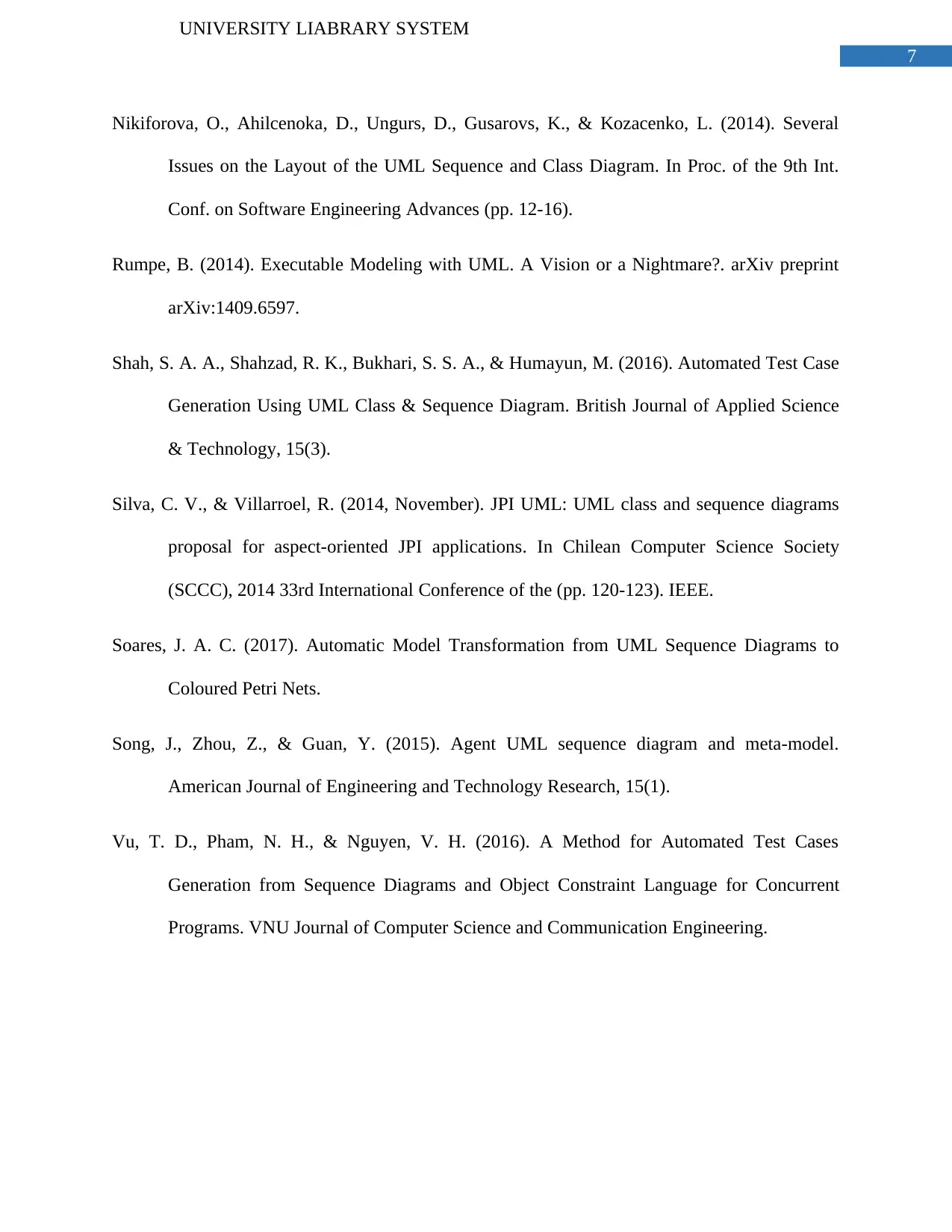
7
UNIVERSITY LIABRARY SYSTEM
Nikiforova, O., Ahilcenoka, D., Ungurs, D., Gusarovs, K., & Kozacenko, L. (2014). Several
Issues on the Layout of the UML Sequence and Class Diagram. In Proc. of the 9th Int.
Conf. on Software Engineering Advances (pp. 12-16).
Rumpe, B. (2014). Executable Modeling with UML. A Vision or a Nightmare?. arXiv preprint
arXiv:1409.6597.
Shah, S. A. A., Shahzad, R. K., Bukhari, S. S. A., & Humayun, M. (2016). Automated Test Case
Generation Using UML Class & Sequence Diagram. British Journal of Applied Science
& Technology, 15(3).
Silva, C. V., & Villarroel, R. (2014, November). JPI UML: UML class and sequence diagrams
proposal for aspect-oriented JPI applications. In Chilean Computer Science Society
(SCCC), 2014 33rd International Conference of the (pp. 120-123). IEEE.
Soares, J. A. C. (2017). Automatic Model Transformation from UML Sequence Diagrams to
Coloured Petri Nets.
Song, J., Zhou, Z., & Guan, Y. (2015). Agent UML sequence diagram and meta-model.
American Journal of Engineering and Technology Research, 15(1).
Vu, T. D., Pham, N. H., & Nguyen, V. H. (2016). A Method for Automated Test Cases
Generation from Sequence Diagrams and Object Constraint Language for Concurrent
Programs. VNU Journal of Computer Science and Communication Engineering.
UNIVERSITY LIABRARY SYSTEM
Nikiforova, O., Ahilcenoka, D., Ungurs, D., Gusarovs, K., & Kozacenko, L. (2014). Several
Issues on the Layout of the UML Sequence and Class Diagram. In Proc. of the 9th Int.
Conf. on Software Engineering Advances (pp. 12-16).
Rumpe, B. (2014). Executable Modeling with UML. A Vision or a Nightmare?. arXiv preprint
arXiv:1409.6597.
Shah, S. A. A., Shahzad, R. K., Bukhari, S. S. A., & Humayun, M. (2016). Automated Test Case
Generation Using UML Class & Sequence Diagram. British Journal of Applied Science
& Technology, 15(3).
Silva, C. V., & Villarroel, R. (2014, November). JPI UML: UML class and sequence diagrams
proposal for aspect-oriented JPI applications. In Chilean Computer Science Society
(SCCC), 2014 33rd International Conference of the (pp. 120-123). IEEE.
Soares, J. A. C. (2017). Automatic Model Transformation from UML Sequence Diagrams to
Coloured Petri Nets.
Song, J., Zhou, Z., & Guan, Y. (2015). Agent UML sequence diagram and meta-model.
American Journal of Engineering and Technology Research, 15(1).
Vu, T. D., Pham, N. H., & Nguyen, V. H. (2016). A Method for Automated Test Cases
Generation from Sequence Diagrams and Object Constraint Language for Concurrent
Programs. VNU Journal of Computer Science and Communication Engineering.
1 out of 8
Related Documents
Your All-in-One AI-Powered Toolkit for Academic Success.
+13062052269
info@desklib.com
Available 24*7 on WhatsApp / Email
![[object Object]](/_next/static/media/star-bottom.7253800d.svg)
Unlock your academic potential
Copyright © 2020–2025 A2Z Services. All Rights Reserved. Developed and managed by ZUCOL.





